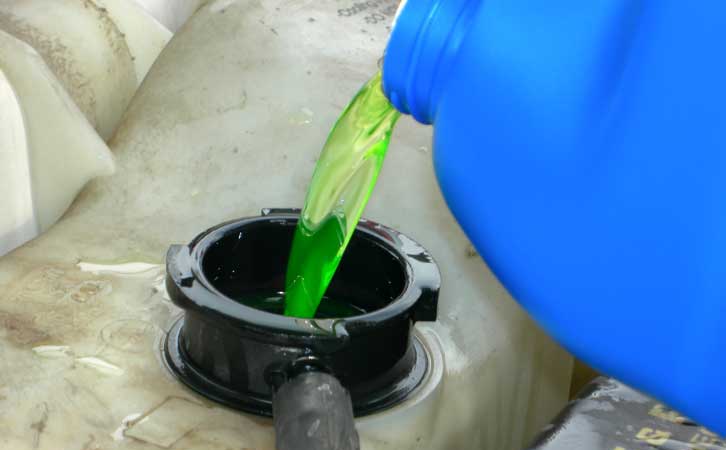The colder months of the year offer a perfect time to re-familiarize yourself with the hazards of ethylene glycol. Its widespread use as an antifreeze and de-icing agent in almost every vehicle on the road means that potential exposures are much more common than you’d think.
Read on for more information about ethylene glycol and how to protect yourself from exposure. For specific Ethylene Glycol SDS information, visit our SDS/MSDS search tool.
What is Ethylene Glycol?
Ethylene Glycol is an odorless, colorless, sweet-tasting viscous liquid. The molar mass of ethylene glycol is 62.07 grams per mole (g/mol) and its specific gravity is approximately 1.1 at room temperature, meaning it is slightly denser than water.
It is most commonly used in antifreeze/coolant formulations for automobiles and other equipment and machinery, as well as chilled-water air-conditioning systems such as those found in large commercial and industrial buildings. Despite its high toxicity, ethylene glycol is still also commonly used as a de-icing agent sprayed on aircraft in extreme cold-weather environments where safer substitutes like polyethylene glycol (PEG) are less effective.
Ethylene glycol also has industrial applications in the production of polyester fibers and resins. One of the most common is polyethylene terephthalate (PET) which is used to make plastic soft drink bottles. In 2016 alone, more than 56 million tons of PET plastic bottles were produced. Ethylene glycol is also widely used in the natural gas industry to remove water vapor from natural gas prior to processing.
Ethylene Glycol Health Hazards
Ethylene Glycol is acutely toxic when ingested. Exposure through ingestion causes symptoms ranging from:
- Drowsiness
- Nausea
- Vomiting
- Unconsciousness
- Seizure
- Coma
- respiratory failure
- Renal (kidney) damage
- Congestive heart failure
- Death
Inhalation of ethylene glycol vapors or mists (such as from de-icing sprayers or presence in poorly ventilated confined spaces) can cause eye and respiratory tract irritation, headache, cough, nausea or vomiting, and may damage the lungs, kidneys and liver in sufficiently high concentrations.
Ethylene glycol is poorly absorbed through the skin, making acute toxicity via dermal exposure unlikely. However, skin exposure will cause irritation and redness. Eye exposure to liquid ethylene glycol may result in swelling of the eye and eyelid or corneal injury. In the event that ethylene glycol gets into the eye, remove the person from the source of exposure immediately, wash the affected eye with large volumes of water and seek medical attention.
Precautions and Safety Tips
Below are some basic precautions when handling or working with ethylene glycol. For full safety and precautionary information, review the safety data sheet (SDS/MSDS) for specific chemical products you use. Visit our SDS/MSDS search tool for ethylene glycol MSDSs and SDSs.
Handling & Storage – Wear personal protective equipment and ensure adequate ventilation. Do not breathe vapors or spray mist. Avoid contact with skin, eyes and clothing. Keep storage containers tightly closed in a dry, cool and well-ventilated place. Ethylene glycol is also combustible, so keep away from heat and sources of ignition.
Personal Protective Equipment (PPE) – Wear appropriate protective eyeglasses or chemical safety goggles as described by OSHA’s eye and face protection regulations in 29 CFR 1910.133 or European Standard EN166. Wear appropriate protective gloves and clothing to prevent skin exposure. Follow OSHA respirator regulations found in 29 CFR 1910.134 or European Standard EN 149. Use a NIOSH/MSHA or European Standard EN 149 approved respirator if exposure limits are exceeded or if irritation or other symptoms are experienced.
First Aid Measures
In case of exposure to or cases of ethylene glycol poisoning, always call a medical professional for advice and first aid measures. The following are examples, not a comprehensive list, of possible first aid measures one could expect to follow:
- Eye contact: Rinse immediately with plenty of water, also under the eyelids, for at least 15 minutes. Get medical attention.
- Skin Contact: Wash off immediately with plenty of water for at least 15 minutes. Get medical attention immediately if symptoms occur.
- Inhalation: Move to fresh air. Get medical attention immediately if symptoms occur. If not breathing, give artificial respiration. Do not use mouth-to-mouth respiration if victim ingested or inhaled the substance. Give artificial respiration with the aid of a pocket mask equipped with a one-way valve or other protective respiratory medical device.
- Ingestion: Do not induce vomiting. Call a physician or Poison Control Center immediately.
Note: The information above is a general guideline for ethylene glycol. For exact first aid measures, review manufacturers’ safety data sheet (SDS/MSDS).
Need to track down the document? Visit our SDS/MSDS search tool. Get access to the industry-leading database of MSDS/SDS documents by signing up for a free trial.
If you need help managing your SDS library or your chemical inventory, our Chemical Management software will give you the support you need. You and your entire workforce will have unobstructed 24/7 access to your entire SDS library from anywhere, anytime. Our chemical ingredient indexing capabilities also provide visibility into your inventory at the ingredient level, cross-reference the ingredients against numerous regulatory lists, and summarize key information about regulatory radar screens and established occupational exposure limits (OELs).
Contact us today to request a demo so you can see for yourself how our Chemical Management software can help you meet regulatory requirements, including the updated HazCom Standard, and keep your entire workforce safe.














